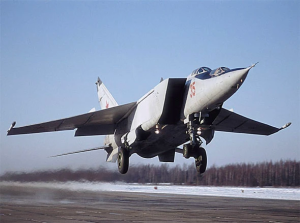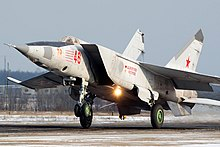The Mikoyan-Gurevich Mig-25, codenamed “Foxbat” by NATO, stands as a legendary symbol of Soviet aviation prowess during the Cold War era. Designed as a high-altitude, high-speed interceptor, the Mig-25 remains an iconic and enigmatic figure in the history of military aviation.

Design and Development: The Mig-25, developed by the Soviet Union’s Mikoyan-Gurevich Design Bureau in the late 1960s, was a response to the evolving strategic landscape and the need for an aircraft that could counter perceived threats from high-altitude, high-speed American bombers. The aircraft’s design prioritized speed and altitude capabilities, making it a formidable interceptor.
The Mig-25’s fuselage is characterized by its long, slender shape, housing two powerful Tumansky R-15 turbojet engines. The aircraft’s wings feature a distinctive swept-back design, enhancing its aerodynamic efficiency at high speeds. With a top speed exceeding Mach 3, the Mig-25 could quickly ascend to altitudes beyond 80,000 feet, making it one of the fastest and highest-flying military aircraft of its time.

Role and Capabilities: Primarily designed for intercepting high-altitude reconnaissance aircraft and strategic bombers, the Mig-25 boasted impressive capabilities. Its powerful radar system could track multiple targets at extreme ranges, while its speed allowed it to close the gap rapidly for interception. The aircraft’s ability to reach high altitudes made it a challenging target for enemy defenses.
Operational History: The Mig-25 made its debut in the early 1970s and played a significant role in the Soviet Air Force’s fleet during the latter part of the Cold War. While its speed and altitude capabilities were commendable, the Mig-25’s limited agility and reliance on outdated avionics technology became apparent in the face of evolving air combat strategies.

Legacy and Impact: Despite its limitations, the Mig-25 “Foxbat” left an enduring mark on the world of military aviation. Its unprecedented speed and altitude achievements set multiple world records, showcasing Soviet technological capabilities. The Mig-25’s design influenced subsequent generations of aircraft, and its presence served as a constant reminder of the Cold War’s technological rivalry.

Conclusion: The Mig-25 “Foxbat” remains a fascinating chapter in the history of aviation, embodying the Soviet Union’s ambitious pursuit of high-speed, high-altitude interceptor capabilities. While the aircraft’s operational history revealed certain drawbacks, its impact on the evolution of military aviation and the lessons learned from its design continue to resonate in the annals of aerospace engineering. The Mig-25’s legacy endures as a symbol of an era defined by technological competition and strategic innovation.





